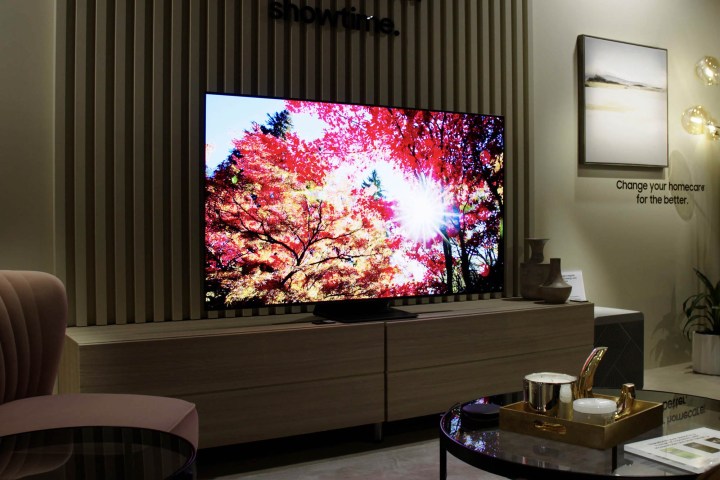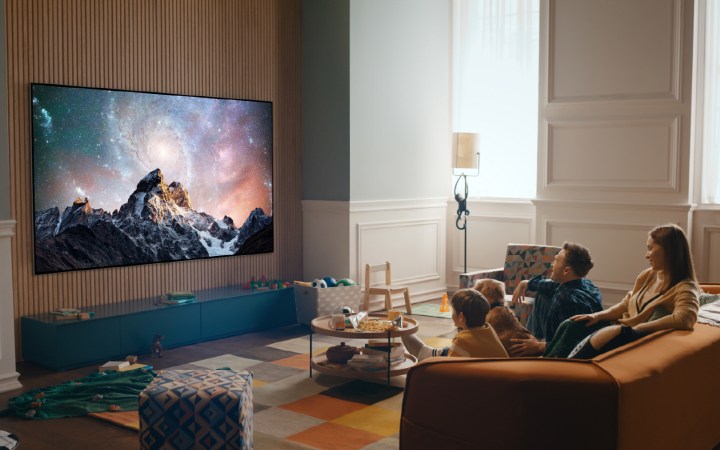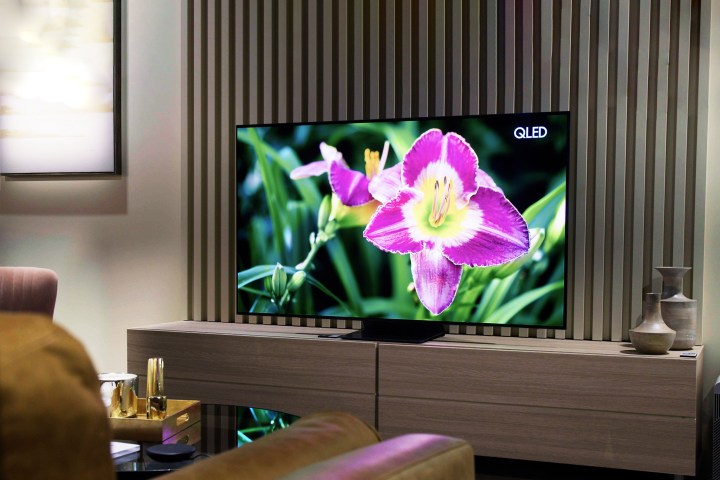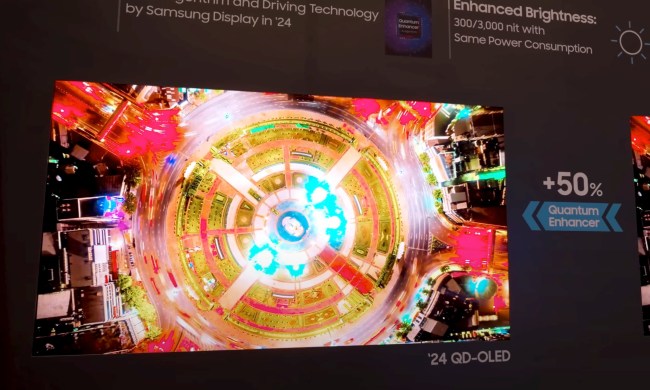There are two ways to go about identifying the best TVs in any given year. The simplest approach uses performance data to objectively determine which TV has the best picture quality. Unfortunately, by that criteria, the winner could cost as much as a car.
The other method weighs a number of other factors. Ease of use. Price. Availability. Advanced features. Position in the market. And whether I like the cut of its jib. Just kidding on that last one … sort of.
Anyway, I am firmly in the camp of the latter. Our list of the Best TVs of 2022 will comprise top performers across various price segments, with price-to-performance ratio, ease of use, gaming compatibility, general availability, and jib-cut all taken into consideration.
And by that standard, I think it’s possible the Samsung S95B OLED might have it this year. And even if it doesn’t end up at the pinnacle of a bunch of lists this year, it’s worth noting the serious pressure the S95B OLED is putting on its competition.
One of two

The Samsung S95B is special because it is one of two TVs you can buy that use Samsung Display’s new QD-OLED technology. The other, which I’ve already spent some time testing and am extremely impressed with, is Sony’s A95K.
QD-OLED is an exciting display technology that pairs blue OLEDs with red and green quantum dots for an emissive display that doesn’t use a color filter or polarizing layer. The result is an efficient display with highly accurate color and greyscale production, perfect black levels, and very impressive contrast. And it is even less susceptible to burn-in than conventional WRGB OLED.
QD-OLED vs. WRGB OLED
TV enthusiasts are excited to debate over which is better: The 10th generation of WRGB OLED pioneered by LG Display, or the first generation of QD-OLED, pioneered by Samsung Display.
For its part, LG Display’s WRGB OLED has seen many incremental improvements and refinements over the past decade, with more sizeable leaps in the last year providing the brightest OLED TVs we’ve seen to date. The WRGB TV to beat this year will be LG’s G2 Evo Gallery Series OLED, though I should also point out that LG’s C2 Series OLED will provide 97% of the performance for less money.
Samsung Display’s QD-OLED may be in its first generation as a consumer product, but it’s been in development for years and has come out swinging. While it can’t hit the peak brightness numbers under certain testing conditions that LG Display’s best WRGB OLEDs can, it has more accurate greyscale, more accurate colors, uses less energy, and is a safer option for gamers who might be worried about burn-in.
But what about QLED?

Oh, don’t worry. I wasn’t going to leave out TV’s other favorite acronym. Truth be told, I am extremely excited about some of 2022’s top-tier LCD-based TVs. Today’s best QLEDs, with their mini-LED backlighting systems, increased off-angle fidelity, massive color volume, and better-than-ever black level performance are looking super stunning.
As we’ll soon discover, though, top-tier QLED TVs that can compete with OLED-based TVs in certain performance areas tend to be pretty pricey.
Who’s in the ring?
I’m bad at sport-fighting metaphors, but let’s just pretend there’s a TV equivalent of a UFC tag-team cage match situation and visualize all the most promising 2022 TVs gathered together in one place, mean-mugging each other with intense brightness, vivid gang colors, and broodingly dark black levels, prepared to ‘TV” each other to the death.
Also, there’s popcorn, because who doesn’t love a salty snack with a good tech throwdown?
So in this octagonal cage we have the LG G2 Evo Gallery Series OLED, the LG C2 Series OLED, the Sony A95K QD-OLED, the Samsung S95B OLED (it’s also a QD-OLED, but Samsung doesn’t call it that because … whatever), the Samsung QN90B, and let’s pretend TCL is hanging back in the locker room waiting to surprise us at the last second, but that dark horse remains in the shadows for now.
Now, let’s look at each contender’s “weight” (that would be the price for each TV at 65-inches) from the top down:
| Sony A95K QD-OLED | $4,000 |
| LG G2 Evo OLED | $3,000 |
| Samsung QN95B QLED | $3,000 |
| Samsung S95B OLED | $3,000 |
| LG C2 Series:OLED | $2500 |
| TCL 2022 6-Series QLED | $?,??? |
With that in mind, let’s take a look at the skills each TV is bringing to the fight.
| Sony A95K QD-OLED | QD-OLED color/efficiency. Sony processing. Two HDMI 2.1 ports. Google TV OS. Sleek design |
| LG G2 Evo OLED | Brightest OLED ever. LG processing. Four HDMI 2.1 ports. WebOS with Gamer dashboard. Nvidia G-Sync and FreeSync. |
| Samsung QN95B QLED | Intensely bright QLED. Samsung processing. Four HDMI 2.1 ports. 144Hz. FreeSync. Tizen OS with Game hub/dashboard. |
| Samsung S95B OLED | QD-OLED color/efficiency. Samsung processing. Four HDMI 2.1 ports. 120Hz. Freesynch. Tizen OS with Game hub/dashboard/ |
| LG C2 Series:OLED | Very bright OLED. LG processing. Four HDMI 2.1 ports. WebOS with Gamer dashboard. Nvidia G-Sync and FreeSync. |
| TCL 2022 6-Series QLED | ??????? |
Elimination round!

Let’s make short work of this, shall we? Here’s how I see this playing out:
The Sony A95K looks amazing, but it has trouble lugging its $1K premium around and fades out early.
The TCL 6-Series punches well above its weight, but it’s still a welter-weight and would get knocked out early if it hopped in this particular ring.
The Samsung QN95B is as quick (and bright) as lighting, but this fight belongs to OLED technology and its heavy-hitting perfect black levels.
The finals

That leaves us with the LG G2, LG C2, and Samsung S95B, and, frankly, it’s too close for me to call right now.
The LG G2 comes in with its super-bright panel and just about every bell and whistle one could want. The Samsung S95B comes in at the same price as the G2, but with newer technology. Will the newer tech win the S95B the title in a head-to-head match? We have to wait to find out. But I think it will be close.
Then we have the underdog LG C2. It doesn’t have the newest tech or the brightest tech. But it’s also $500 less and has everything anyone actually needs. The LG C2 is more accessible, and that fact alone could make it the winner.
Gut check

I don’t know what it is about the S95B, but something in my gut tells me it’s going to surprise me once I’ve got it on the test bench. Will it wind up being the best TV in 2022? I really can’t say. But it’s gonna be a thrill finding out.



